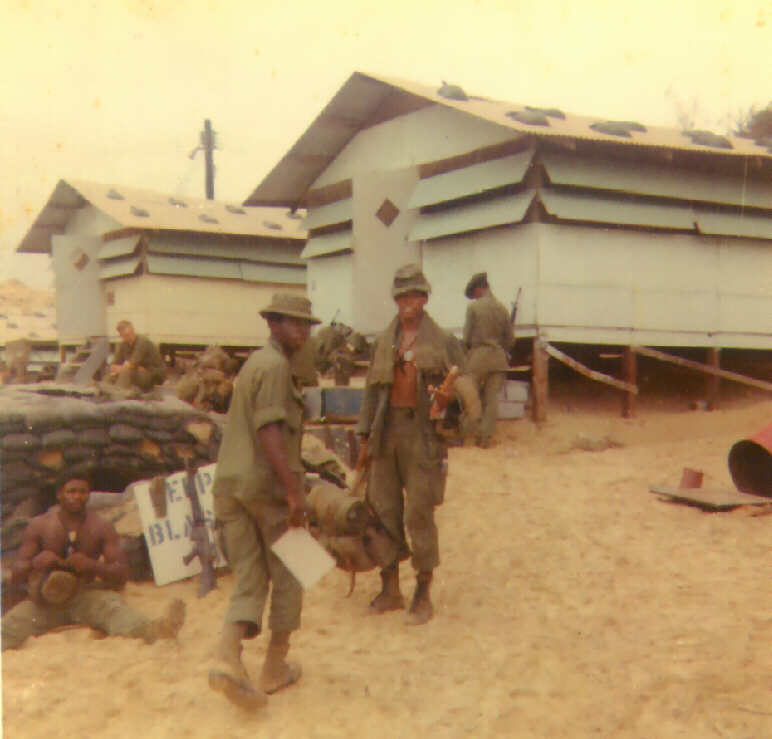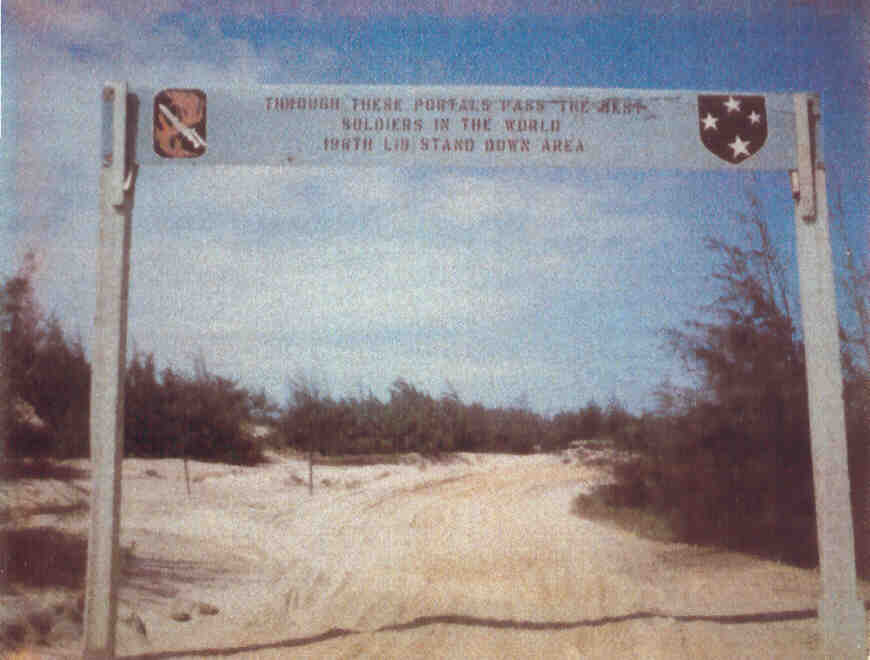Commando
Raid at Chu Lai
On 31 July 1970, at 0245 hours, a balmy night at the Chu Lai Replacement
Center was
shattered by the sound of three large explosions from the Refit Area
(BT 546 043) nearby on the
vast Americal Division base camp at Chu Lai, Vietnam. The new
replacements thought the base
was coming under a rocket attack from the infamous “Rocket Pocket”
five miles away, but the
Viet Cong strike had been much more daring. They had attacked
the 198th Infantry Brigade Stand
Down "Refit" area where the soldiers from the line units returned for
a short "R&R" break from
the war.

Soldiers from B Co. 1st Bn 6th Inf arriving on a late
afternoon in 1970 at the 198th Inf Bde Refit
area for a two day long break from the war. Link
to additional photos of the "Refit" area.
D Co. 1st Battalion 6th Infantry had just arrived the evening
before at the Refit Area for a
well earned respite from constant combat patrols performed in the preceding
weeks. Several
officers from Delta Company were relaxing and playing cards in the
officers hootch in the Refit
Area when the first satchel charge detonated and demolished their hootch.
Fortunately, they were
congregated around a bunk at the far end of the building from where
the explosion occurred. The
officers were jarred by the explosion and struck by flying debris,
but no one was seriously injured.
Several minutes later the arms room in the Refit Area was totally destroyed
by a second
explosion, and a driver from the headquarters was slightly wounded.
Seven M16 rifles and four
M79 grenade launchers were damaged, but were later determined to be
repairable. Shortly
thereafter, several of the bunkers protecting the perimeter of the
Refit Area were destroyed by
additional explosions.
As could be expected, the troops were stunned by the attack in
a supposedly secure area. Although
the Refit Area was only a few hundred yards from the beach, it was
more than a mile from the base
perimeter in all other directions. Several of the soldiers left
the Refit Area and spent the remainder
of the night at the troop Replacement Center nearby where newly arrived
soldiers were billeted.
Although daring, the Viet Cong attack was not perfect in execution.
Not all of explosives detonated
at the same time as intended. Two more explosions rocked the
area at 0630 hours and destroyed two
hootches that would have been occupied by enlisted soldiers several
hours before. Fortunately,
SGT Bud Carlson, a squad leader in 2nd Plt., had been sleeping in a
hammock outside the hootches.
He was awakened by the first explosion, and ran soldiers, who had not
been roused, out of the hootches
like "a Basic Training Drill Sergeant."
Mine dogs and mine sweep teams were brought in to thoroughly search
the Refit Area for
any further explosive devices or booby traps. When none were
found, the area was declared to be
secured. Unfortunately, the search had not been effective, for
another large explosion in the Refit
Area at 1900 hours destroyed the medical aid station. Two medics
from D Co., 1st Bn 6th Inf,--
PVT John R. Feaster and PFC David B. Haskell – were seriously wounded
by the massive
fragmentation effects of the explosives. They were taken by helicopter
the the 91st Evacuation
Hospital only a few miles away on the sprawling Americal Division Chu
Lai base area. At that
point the Refit Area was declared to be unsecured and all personnel
were evacuated.
Further investigation of the incident revealed that three Viet
Cong commandos apparently
swam in from the South China Sea toward the Americal Division base
area. They had crawled
ashore on the beach where a small stream emptied into the sea (probably
at BT 558 052).
Although the sandy area they had crossed was illuminated, the slight
depression caused by the
stream was located between two guard towers. Their foot prints
made a loop into and out of the
Refit Area locations where they had set the six explosive charges,
each weighing 16 to 24 pounds.
Depressions in the sand and bushes showed that they had hidden in the
dunes just behind the Refit
Area while they planned their attack.

THROUGH THESE PORTALS PASS THE BEST SOLDIERS IN THE
WORLD 198th LIB STAND DOWN AREA
1970 photo provided by Terry Ivey (C/1-6 Inf).
[Note: references to the commando raid in the 198th Inf Bde
and
1st Bn 6th Inf TOC journals identify the location of
the attack as the "Refit area." The Stand Down Area identified
by this sign and the "Refit area" are at the same
place. The sandy soil, the low dunes visible on the left side of
the
photo, and the dense but scattered vegetation are the
type that concealed the Viet Cong commandos during
their daring attack.]
Beach guard tower and concertina wire at the 198th Inf Bde
Refit Area swimming beach. 1970 photos for
this panorama view are from a 8 mm film shot by by Lynn
Baker (D/1-6 Inf 1969-70). Note the small light (white
triangle) on right side of photos used to illuminate
the shore at night on the perimeter of the base area.
The Viet Cong commando raid was a complete success. They
either evaded out to sea in
the darkness or blended in with the Vietnamese workforce that came
onto the base camp each
day. The Viet Cong tactics had been precise and ruthless – strike
at the soldiers when their guard
was down and they least expected an attack; kill the leaders first;
then destroy their weapons and
means of defense; and afterwards kill any that had made it to their
defensive positions. Finally,
use time delayed fuses to blow up the medical aid station to further
demoralize any of the soldiers
that survived the first series of explosions.
Anyone having additional information about this incident, please
contact wr9r@aol.com
[This story is based on the following sources: the 1st Bn 6th Inf S2/S3/S5
TOC Journal; the 198th
Inf Bde TOC Journal; Americal Division casualty logs; interviews
with 1LT Bill Cain and SGT Bud
Carlson, D/1-6 Inf; and, personal observations at the scene by 1LT
Wayne R. Johnston, 1/6 Inf.]
Use back arrow or link to Stories
selection page or to the 1st Battalion 6th Infantry Home
Page


